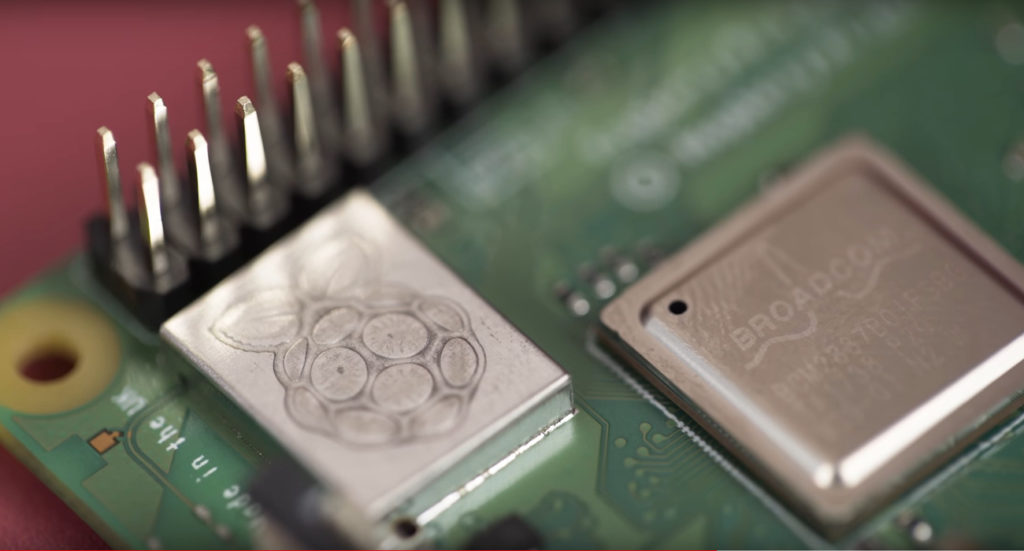The Raspberry Pi Foundation has released the Raspberry Pi 3B+ as the updated version of the RPi 3B without much notice. The predecessor, the 3B model, has now been available on the market for around two years and a revision was eagerly hoped for by many.
However, the day of publication, 03/14/2018, is no coincidence. March 14th comes in American spelling as 3/14 or 3-14 and is the unofficial holiday of the circle number Pi, the so-called Pi Day.
The Raspberry Pi 3B+ has the same dimensions as its predecessor, so that the existing cases and plug-in modules can continue to be used without problems. Much else remains the same and the differences are manageable. Only in the decisive places was hand applied.
Technical differences
| RPi 3 B+ | RPi 3 B | |
|---|---|---|
| Release | March 2018 | February 2016 |
| Size | 85,6 × 56mm | 85,6 × 56mm |
| SOC | BCM2837 | BCM2837 |
| CPU | ARM Cortex-A53 (ARMv8-A) |
ARM Cortex-A53 (ARMv8-A) |
| CPU cores | 4 | 4 |
| CPU clock | 4x 1400 MHz New | 4x 1200 MHz |
| RAM | 1024 MB | 1024 MB |
| USB | 4x USB2.0 | 4x USB2.0 |
| Audio | HDMI (digital) 3,5mm jack |
HDMI (digital) 3,5mm jack |
| Network | 10/100/1000 MBit New | 10/100 MBit |
| Wlan | 2,4/5 GHz WLAN ac New | 2,4 GHz WLAN b/g/n |
| Bluetooth | Bluetooth 4.2 New | Bluetooth 4.1 |
| GPIO | 40 Pins | 40 Pins |
| PoE | yes (prepared) New | no |
| power input | max. 7 W | max. 4,4 W |
| power source | 5V Micro USB min. 2,5 A |
5V Micro USB min 2,5 A |
| Price | ca. 45$ | ca. 38$ |
| Shop | Shop |
What’s new with the Raspberry Pi 3 Model B+?
- Faster network
Thanks to the new LAN7515 chip, Gigabit Ethernet is finally supported. However, you cannot expect the full gigabit data rate. The reason for this is that the chip hangs internally on a USB 2.0 controller, so 315 Mbit/s is the end. In its predecessor, the Raspberry Pi 3B, the speed was only 95 Mbps. Thus one can be completely content with the increase. - Higher CPU clock
The four ARM cores have also been improved. These now clock at 1.4 GHz instead of 1.2 GHz and are therefore around 17% faster. A sheet metal lid serves as a heat spreader to better dissipate the waste heat associated with the increased clock frequency. However, the higher clock speed also results in higher power consumption. - 5 GHz WLAN ac
The Broadcom BCM43455 is a new WLAN controller. This now supports dual-band ac WLAN for the 5 GHz frequency band. Instead of two, however, only one antenna is installed, so that the throughput increases only moderately. - Power-over-Ethernet (prepared)
The Raspberry Pi 3B+ now has 4 pins for PoE on the board. A PoE HAT for the Raspberry Pi, which can supply the Raspi with up to 12.95 watts (IEEE 802.af), will be available soon.
First measurements
Meanwhile I could measure the new Raspberry Pi 3B+ and the power consumption turns out fortunately less dramatically, than first assumed.
Test setup
- Raspberry Pi 3B+ / 3B without case
- Network via cable to GBit switch
- OS: Raspbian Stretch Lite (Image 2018-03-13)
- Two measurements: Idle and under load
(“sysbench –test=cpu –cpu-max-prime=20000 –num-threads=8 run“) - Room temperature: approx. 22°C
Test results
| RPi 3 B+ | RPi 3 B | |
|---|---|---|
| Watt, Idle | 2,3 W | 1,3 W |
| Watt, Load | 5,4 W | 3,7 W |
| Temperature, Idle | 44 °C | 40 °C |
| Temperature, Load | 66 °C | 75 °C |
My test conclusion
The RPi 3B+ has a significantly higher power consumption (approx. +80%) than its predecessor. At full load, it is still approx. 45% higher than that of the RPi 3B. However, thanks to the new heatspreader, the RPi 3 B+ is around 10°C cooler than its predecessor. Since the Raspberry Pi automatically reduces the clock rate from a temperature of 85°C, the lower temperature of the RPi 3B+ is a real advantage. This means that the extra power can really be called up without it getting into throttling.
Is it worth replacing the Raspberry Pi 3B with the 3B+?
Maybe. That depends on what the Raspberry Pi is used for. If the focus is on CPU performance, such as in a media center, the new 3B+ will of course do better justice to the task. The same applies to high network throughputs. If, on the other hand, an energy-saving, cool system is required, then there is no reason to change. The price of the new RPi 3B+ and its predecessor is identical.
Note: There is a rating embedded within this post, please visit this post to rate it.
